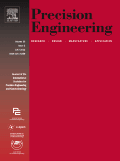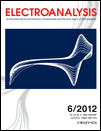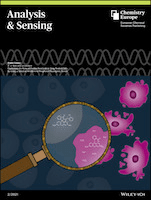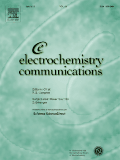
Sensors and Actuators Reports
metrics 2024
Pioneering Research in Physics, Computer Science, and Engineering
Introduction
Sensors and Actuators Reports, published by Elsevier, is a premier open access journal that has been contributing to the fields of physics, computer science, and engineering since its establishment in 2019. With its ISSN 2666-0539, this journal has rapidly gained recognition, achieving Q1 quartile rankings across multiple categories, including Atomic and Molecular Physics, Computer Science, and Electrical Engineering. By providing a platform for high-quality research and innovative findings, Sensors and Actuators Reports is dedicated to advancing knowledge in sensor and actuator technologies, which are pivotal for numerous applications in modern science and industry. The journal's performance is underscored by its impressive Scopus rankings, placing it in the top tiers across various disciplines. Open access ensures that research is widely disseminated, fostering collaboration and enabling researchers, professionals, and students alike to engage with the latest advancements in their fields.
Metrics 2024
 0.90
0.90 6.50
6.50 6.50
6.50 22
22Metrics History
Rank 2024
Scopus
IF (Web Of Science)
JCI (Web Of Science)
Quartile History
Similar Journals

PRECISION ENGINEERING-JOURNAL OF THE INTERNATIONAL SOCIETIES FOR PRECISION ENGINEERING AND NANOTECHNOLOGY
Unleashing Potential: The Nexus of Precision and InnovationPRECISION ENGINEERING - JOURNAL OF THE INTERNATIONAL SOCIETIES FOR PRECISION ENGINEERING AND NANOTECHNOLOGY, published by Elsevier Science Inc, stands at the forefront of advancements in engineering and nanotechnology since its inception in 1979. With a commendable impact factor and a ranking of Q1 in Engineering and Q2 in Nanoscience and Nanotechnology, this journal offers a premier platform for disseminating cutting-edge research that merges precision engineering with nanotechnology innovations. Its Scopus ranking positions it within the top 13% of journals in general engineering, making it an essential resource for academics and industry professionals alike. Although it does not currently offer open access, the journal promotes high-quality, peer-reviewed research that is crucial for ongoing developments in the field. Researchers, professionals, and students dedicated to precision engineering and related disciplines will find this journal to be an invaluable repository of knowledge and ideas.

ELECTROANALYSIS
Pioneering Insights in Analytical and Electrochemical ScienceELECTROANALYSIS is a premier journal published by WILEY-V C H VERLAG GMBH that serves the dynamic field of analytical and electrochemistry. Established in 1989, this scholarly publication has successfully converged its focus to cover a wide array of topics including novel electrochemical methods, sensor technology, and environmental analysis, reflecting the latest advancements and trends in the field. With an impressive 2023 impact factor that places it in the Q2 quartile of Analytical Chemistry and Q3 quartile in Electrochemistry, the journal is recognized for its high-quality research and contributions. Its Scopus rankings further reinforce its credibility, standing at #46/156 in Analytical Chemistry and #26/60 in Electrochemistry. Although currently not offering Open Access, the journal remains a significant resource for researchers, professionals, and students keen to stay at the forefront of electroanalytical techniques. With a global readership, ELECTROANALYSIS continues to drive knowledge and innovation within the scientific community.

Journal of Analysis and Testing
Exploring the forefront of analytical methodologies.Journal of Analysis and Testing is a premier academic journal published by SPRINGER SINGAPORE PTE LTD, dedicated to advancing the fields of analytical and environmental chemistry. With ISSN 2096-241X and E-ISSN 2509-4696, the journal has established a significant presence since its inception in 2017, converging its focus until 2024. The journal's outstanding rankings in 2023, including Q1 quartile placements in Analytical Chemistry, Instrumentation, and Spectroscopy, underscore its pivotal role in disseminating high-quality research. Researchers can access cutting-edge studies that explore innovative testing methodologies, electrochemical analyses, and material evaluations, making it an essential resource for professionals and students alike. The Journal of Analysis and Testing not only celebrates advances in science and technology but also promotes interdisciplinary collaborations, ensuring widespread impact across analytical and environmental domains. As such, this journal plays a vital role in shaping the future of analytical practices and methodologies, positioning itself as a key conduit for knowledge exchange in the scholarly community.

Journal of Electroanalytical Chemistry
Driving Discoveries in Analytical Chemistry and BeyondThe Journal of Electroanalytical Chemistry, published by Elsevier Science SA, stands as a leading platform for the dissemination of cutting-edge research in the field of electroanalytical science. With an impressive impact factor that reflects its esteemed reputation—ranking in the Q1 category for both Analytical Chemistry and Chemical Engineering, alongside a strong presence in Electrochemistry—this journal provides a vital resource for researchers, professionals, and students alike. Covering topics from fundamental electrochemical processes to innovative analytical techniques, the journal aims to foster an in-depth understanding and discussion of contemporary advancements in electroanalytical methodologies. Operating under a model that prioritizes quality and rigor, it facilitates access to high-quality manuscripts and reviews that contribute to the advancement of the field. For over six decades, from 1959 to 2024, it has played an intrinsic role in shaping the landscape of electrochemistry, continually driving forward the frontiers of knowledge and application.

Chemosensors
Connecting Researchers in the Realm of ChemosensorsChemosensors is a distinguished open-access journal published by MDPI, focusing on the innovative field of analytical chemistry and physical and theoretical chemistry. Since its inception in 2013, the journal has rapidly established itself as a pivotal platform for the dissemination of cutting-edge research related to the development and application of chemical sensors, encompassing various methodologies and technologies that contribute to advancements in diagnostics, environmental monitoring, and industrial applications. Based in Switzerland, the journal operates with a commitment to accessibility, ensuring that all published articles are freely available to a global readership. With a current impact factor that positions it in the Q2 quartile for both Analytical Chemistry and Physical and Theoretical Chemistry, Chemosensors attracts a diverse audience of researchers, professionals, and students eager to explore new findings and foster collaborative efforts in sensor technology and its applications. As it continues to grow, Chemosensors remains devoted to advancing scientific knowledge and innovation in its field, making significant contributions to the global scientific community through its rigorous peer-review process.

Journal of Sensors
Empowering the Next Generation of Sensor SolutionsJournal of Sensors, published by HINDAWI LTD, is a prominent peer-reviewed academic journal dedicated to the rapid dissemination of significant findings in the field of sensory technology and its applications. Established in 2008 as an Open Access journal, it aims to provide unrestricted access to valuable research outputs for researchers, professionals, and students alike. With an impressive convergence period from 2009 to 2024, the journal features a diverse range of articles that cater to various categories, including Control and Systems Engineering, Electrical and Electronic Engineering, and Instrumentation, each currently ranked in the Q3 quartile for 2023. The journal is notable for its international scope, as evidenced by its foundation in the United States and backing from a reputable publisher. With a commitment to fostering innovation and collaboration in sensor technology, the Journal of Sensors stands as a vital resource within the academic community, encouraging the exploration and development of cutting-edge sensor systems and applications.

Analysis & Sensing
Exploring Innovative Techniques in ChemistryAnalysis & Sensing is a prominent academic journal published by WILEY-V C H VERLAG GMBH, focusing on the critical fields of Analytical Chemistry, Electrochemistry, Spectroscopy, and Biochemistry. Established within the converged years from 2021 to 2024, the journal aims to advance knowledge in analytical and sensing techniques, providing a platform for high-quality research that reflects current trends and challenges in the scientific community. With a Scopus ranking that highlights its credibility—ranking 101st in Analytical Chemistry and 43rd in Electrochemistry—the journal caters to researchers, professionals, and students striving to enhance their understanding of analytical processes and methodologies. Although not open access, the quality of the articles published ensures a rigorous peer-review system, making it a vital resource for those who wish to remain at the forefront of research innovation in analytical sciences. Additionally, its global reach, indicated by its effective dissemination and relevance, underscores the journal's significance within the realm of chemical research.

ELECTROCHEMISTRY COMMUNICATIONS
Pioneering Open Access Research in ElectrochemistryELECTROCHEMISTRY COMMUNICATIONS, published by ELSEVIER SCIENCE INC, is a leading journal in the field of electrochemistry, holding a prestigious position in the Q1 quartile since 2023. With an impact factor reflecting its esteemed reputation, the journal ranks #15 out of 60 in the Scopus Chemistry category for Electrochemistry, placing it in the 75th percentile. Since adopting an Open Access model in 2019, it has garnered widespread visibility and accessibility, enabling researchers and professionals to share groundbreaking findings and foster innovation. Covering a wide range of topics from fundamental electrochemical research to practical applications, ELECTROCHEMISTRY COMMUNICATIONS serves as a critical platform for disseminating knowledge and advancing the field. The journal's commitment to quality and relevance positions it as a vital resource for academics and practitioners striving to stay at the forefront of electrochemical science.

ANALYTICAL AND BIOANALYTICAL CHEMISTRY
Driving Excellence in Bioanalytical MethodologiesANALYTICAL AND BIOANALYTICAL CHEMISTRY, published by SPRINGER HEIDELBERG, is a leading international journal that serves as a vital platform for innovative research in the fields of analytical and bioanalytical chemistry. With an impressive impact factor and ranking in the Q2 category for both Analytical Chemistry and Biochemistry, the journal highlights key advancements and methodologies that drive the discipline forward. Established in 1996 and continuing vigorously into 2024, it has gained significant recognition with Scopus rankings placing it in the 83rd and 78th percentiles within its categories, underscoring its impact and relevance. The journal's commitment to open access facilitates widespread dissemination of critical scientific knowledge, making it an essential resource for researchers, professionals, and students dedicated to exploring the complexities of chemical analysis. With its base in Heidelberg, Germany, ANALYTICAL AND BIOANALYTICAL CHEMISTRY continues to inspire and influence the global research community.

Photonic Sensors
Illuminating Innovations in Photonic ResearchPhotonic Sensors is a premier open access journal published by Springer, focusing on the rapidly evolving fields of Photonics, Materials Science, and Optics. Since its inception in 2011, this journal has become a vital platform for disseminating cutting-edge research and innovative applications in photonic technologies, addressing a range of topics from optical sensors to advanced materials for photonics. With an impressive impact factor and categorized in the Q2 quartile across both Atomic and Molecular Physics and Electronic, Optical and Magnetic Materials, it ranks among the top publications in its field (47th out of 284 and 38th out of 224, respectively, in Scopus). The journal actively encourages contributions that not only advance theoretical understanding but also pave the way for practical solutions in various industries. Photonic Sensors is essential reading for researchers, professionals, and students keen on exploring the frontiers of photonic research, with open access ensuring wide visibility and engagement within the scientific community.